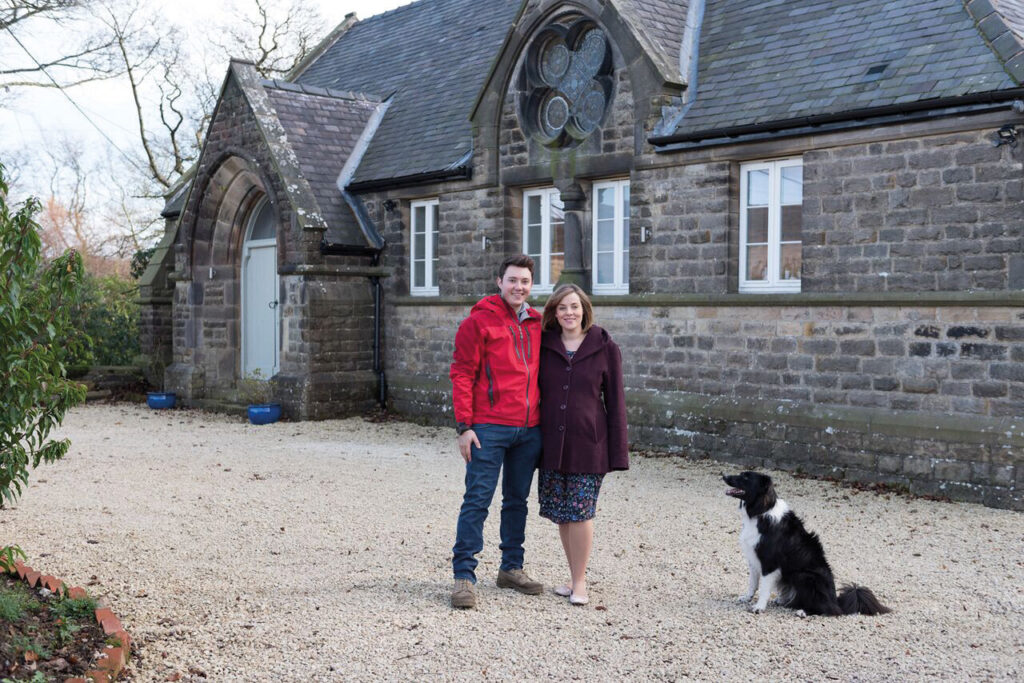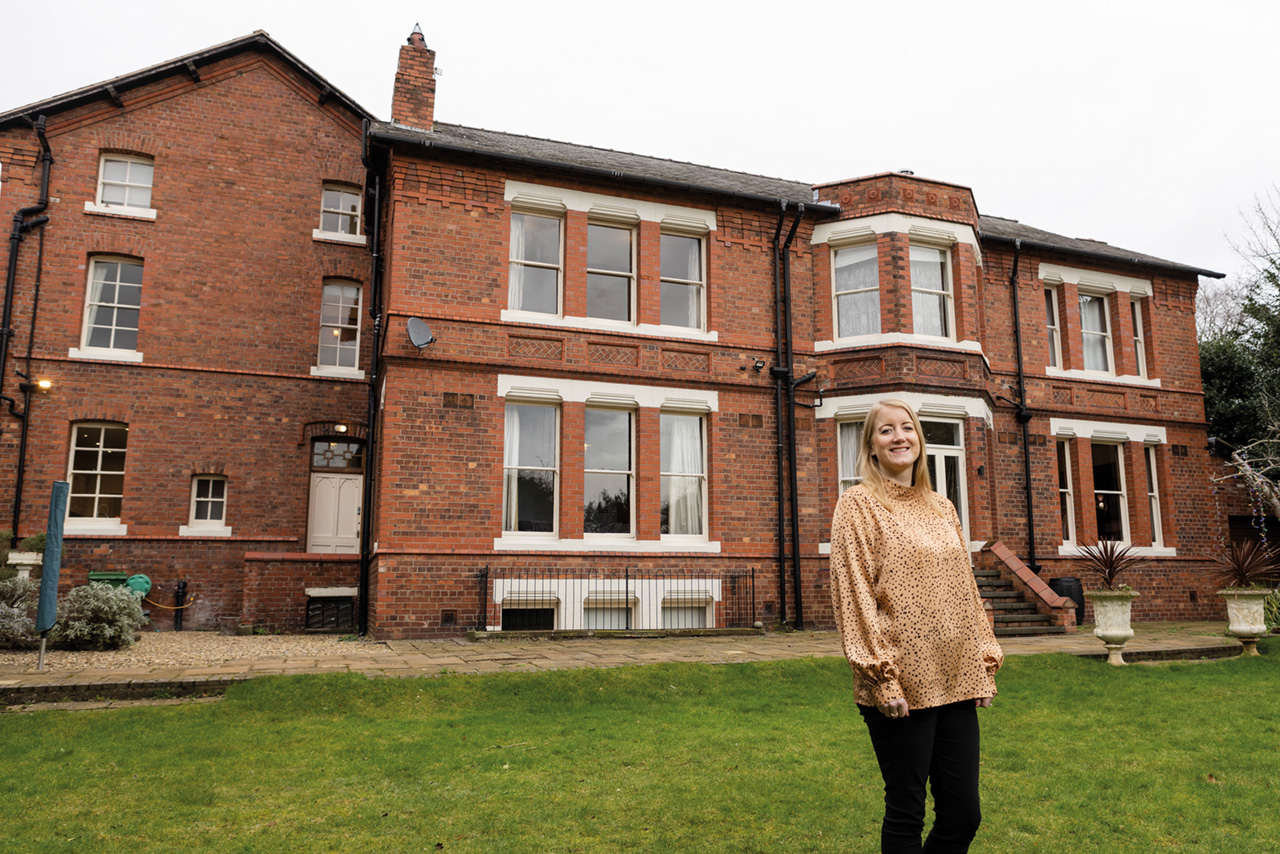Shared ownership
Helen Pritchard’s delivery driver got married in her home when it was a hotel. Saskia Murphy talks to the residents of properties whose shared history makes them feel more like custodians than owners
As a child growing up in Grappenhall, Helen Pritchard always wondered what it would be like to live in a house like the ones on Balmoral Road.
A tree-lined street on the edge of the Manchester Ship Canal, just outside Warrington, Balmoral Road is made up of grand, gated private residences with large, lawned gardens at the rear.
“I grew up around the corner,” says Pritchard. “I’d walk around these streets and just think all these houses were beautiful. I wondered what you’d have to do to live in a house like this.”
The houses on Balmoral Road remained a distant dream to Pritchard for most of her adult life, until last year, when she and her partner Stu became proud owners of one of the street’s seven-bedroomed mansions, Balmoral House, after each finding success with their respective businesses.
“Dad told me it had been a maternity hospital and he was born in one of the rooms in 1949.”
When Pritchard turned the key in the lock for the first time, she knew she was lucky. But by then she’d also discovered a personal family connection to her new home. On her second visit to the house, before she put an offer in, Pritchard decided to take her mum and dad with her for a look around. At that point she was unaware of the house’s historical significance, but her dad recognised it straight away.
“Dad turned to me and just said: ‘I was born here,’” says Pritchard. “He told me it had been a maternity hospital once upon a time, and he was born in one of the rooms in 1949.”
The previous owner, who was showing them around, told them she knew exactly which room Pritchard’s father would have been born in, because there was only one birthing room when the maternity hospital was running.
“She took us up and showed us. It’s just a spare room now. But it’s a really nice feeling to know that my dad was born here, and that the house is a part of our family history. Obviously, my grandma was here when she was giving birth to him and nursing him.
“The house still has the maternity bells on the wall in the living room as a reminder of that period.”
A research pack Pritchard inherited with the house reveals more of its history.
The building was commissioned by Dr John Hankinson Gornall and completed in 1886. A surgeon and justice of the peace for the borough, Gornall was appointed medical officer for Warrington in 1874 and built the house as a private residence the following decade. His son, Dr Richard Guest Gornall, carried on the family tradition in 1935 when he was appointed a consultant physician. He was well respected for his work to eradicate tuberculosis in Warrington by highlighting the insanitary conditions of slums.
In the 1930s he turned the family home into a maternity home, which he ran for almost 20 years. The Gornall family sold the house, and in the 1980s it became a hotel.
“As we were going through the buying process, we met more people who had connections to the house,” says Pritchard. “My mortgage broker told me she used to work here when she was younger as a waitress when it was a hotel. My delivery driver told me he got married here in the eighties. My sister came over with her friend and she told me her mum was born here, or people will say ‘so-and-so was married here’. That just gives it a lovely feeling: all the good things that have happened here, all the babies that have been born, all the weddings that have taken place.

“The house has got an amazing feeling. You can really feel the history. You can feel the energy. It feels like an honour to own it and take care of it and to be a custodian of it.”
Custodian. It’s a word that strikes a chord with Helen Gill, who in April 2019 became the owner of Rise Hall, Yorkshire’s largest privately owned Grade II stately home and now a wedding and events venue.
For fans of DIY and restoration TV shows, the name Rise Hall might ring a bell. In 2001 TV host and property expert Sarah Beeny purchased the manor with her artist husband Graham Swift.
By the time the house came into Beeny’s ownership, it had fallen into disrepair and needed extensive restoration work.
In November 2010 Channel 4 aired Beeny’s Restoration Nightmare, showing the couple’s plans for the renovation of Rise Hall as a family home and wedding venue.
It was nine years later when the custodianship of the property was handed to Gill and her husband Dan, but by then they had been working at the house for almost a decade after helping Beeny set the property up as a wedding venue.
“When they decided to sell, it was a sort of obvious thing for us to do, because we knew the property. We knew how well it worked. So naturally, we decided to take the plunge and buy it,” says Gill.
Like Balmoral House, Rise Hall is steeped in history. The earliest record of the estate is in the Domesday Book of 1086, where it is listed under the ownership of King Cnut, the 11th century ruler of territories across northern Europe including Denmark, England, Wales, Scotland and Norway.
Throughout the centuries Rise passed through the hands of a string of well-heeled owners and royalty, including King Richard III.
During the Second World War it was requisitioned, serving as headquarters for the operation of searchlight batteries in the local area. During Beeny’s renovation she and her husband discovered graffiti on the walls inside the building, giving information about the officers who were stationed there.
In 1946 Rise Hall transformed again, becoming a convent school dedicated to St Philomena.
These days Gill hosts afternoon tea events at the property, where she gives a guided tour of the house, so she has had to become well versed in facts about the Rise Hall of the past.
“A lot of the people who come back are the old girls from when it was a school, so if you get it wrong, they tell you,” says Gill. “The old girls tell me there is a secret tunnel in the library. I’m still looking for it, but we haven’t found it yet.”
Like Pritchard, Gill is used to hearing stories from strangers about her house’s history, and echoes Pritchard’s sentiments that to own a house with such a rich heritage is to be its guardian or overseer, rather than its permanent owner,
“It’s a real privilege to own a piece of history,” says Gill. “But in a sense, Rise Hall belongs to everybody, because there are so many people who were there at school, or who worked there, or who got married there.
“It’s slightly weird, I guess, people coming up and telling you things about your house that you don’t know, which has never happened to me anywhere else. We’re not so much the permanent owners of it, but the current owners, if that makes sense.”
In Hollow Meadows, a village outside Sheffield, Jessica Allen is another homeowner whose house is well known in the community.
“We live in a former Methodist church,” says Allen, who converted the property into a family home after buying it in 2012. The building then became home to her jewellery company Jessica Flinn, which was based at the church for six years before the company outgrew it.
Hollow Meadows Methodist Church had been empty for more than five years before Allen and her husband Oliver put the offer in, but once upon a time it had a congregation of just eight people.
“It’s in the middle of nowhere, so it’s not really somewhere you can walk to, which I think might have been its biggest issue,” says Allen.
“Because it was a Methodist church it had to go through the committee to decide if we were an acceptable couple to sell to. It took about six months for them to sign and agree we were all right. I think they picked us because we said we wanted to live in it. We weren’t going to convert it and then sell it off.
“When we got the keys, it was just an empty church hall basically. There was some terrible paintwork, a few dodgy signs. There was a hilarious sign on the back of the door which said: ‘What to do if the preacher doesn’t arrive… Number one: don’t panic.’”
These days the old church, built in the late 1800s, has been given a Grand Designs-esque makeover. It has its own well supplying water, and the family has built a mezzanine floor to make room for bedrooms and a bathroom, but the Hollow Meadows community hasn’t forgotten its previous life.
“People tell us about funerals they have been to in our house, which always makes me laugh,” says Allen. “Luckily we didn’t find any bodies when we were renovating.”
Like the owners of Balmoral House and Rise Hall, Allen’s property is one that many people in her community share an attachment with.
“Our neighbours watched over it while it was empty, so there was a real sense of everyone keeping an eye on it.”

Leave a reply
Your email address will not be published.